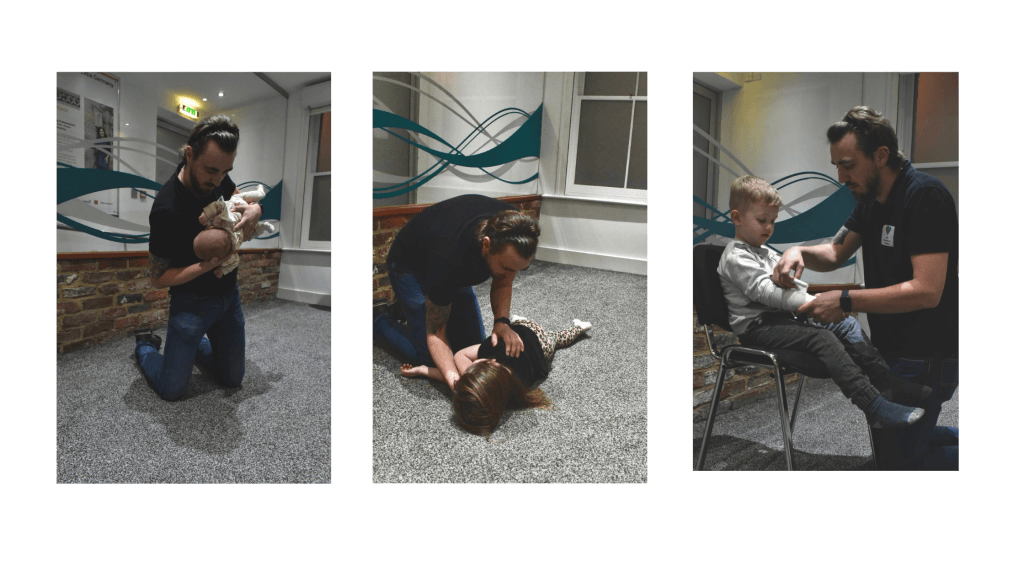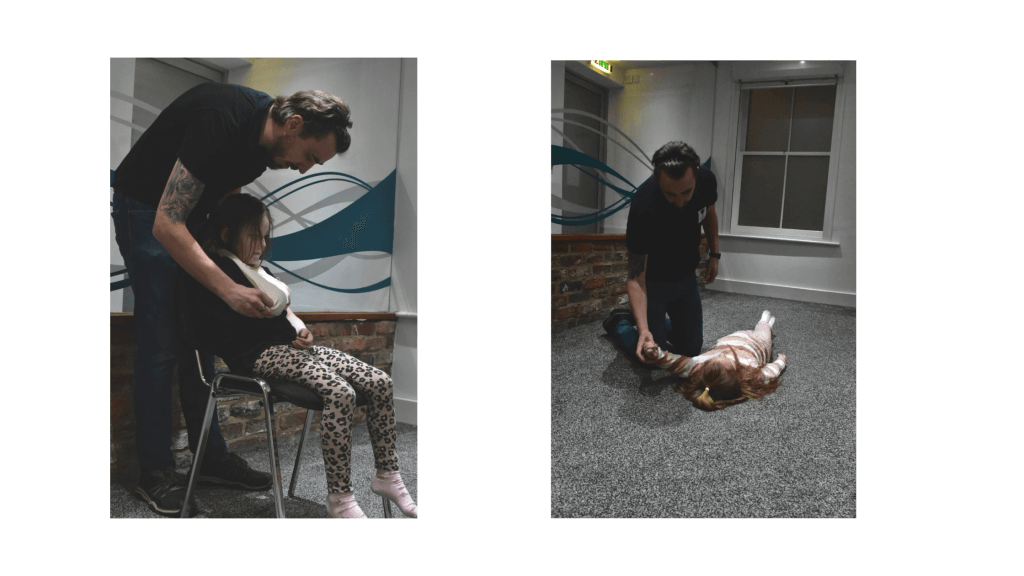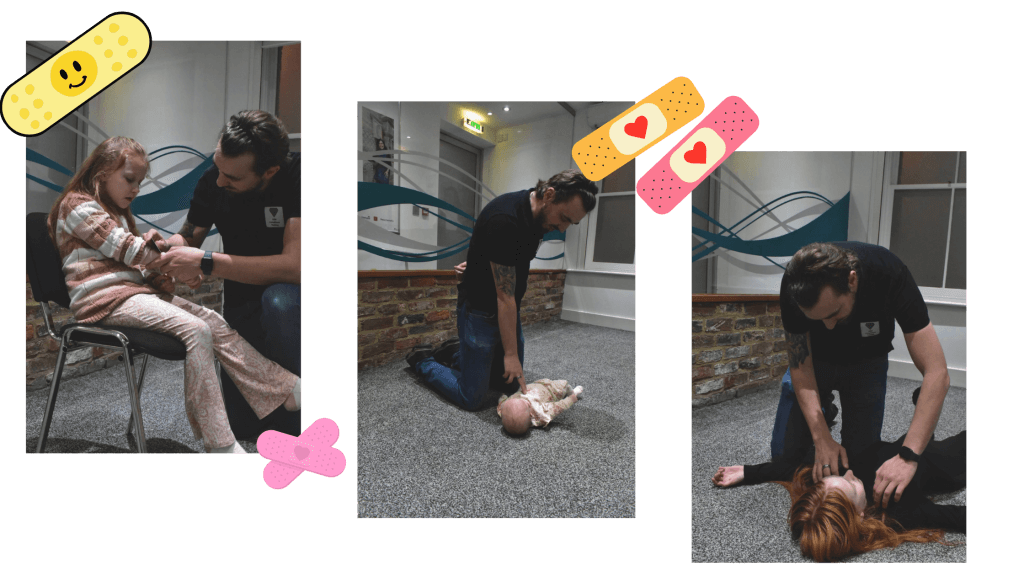We feel the need to explore Paediatric First Aid further, because it is important to answer the question : “Are the children in safe hands?”
If you have ever been required to provide First Aiders as a part of your legal operations, then you will know how confusing the guidelines can be. However, failure to provide accurate First Aid provision would be in violation of the Health and Safety (First Aid) Regulations 1981 in the United Kingdom and could result in:
- Legal Consequences: Non-compliance with First Aid regulations, such as the Health and Safety (First Aid) Regulations 1981 in the United Kingdom, may result in legal consequences. Authorities may issue improvement notices, prohibition notices, or take legal action against the organisation.
- Financial Penalties: Regulatory bodies have the authority to impose financial penalties on organisations that fail to comply with First Aid regulations. Fines can vary depending on the severity of the breach and the level of risk posed by the lack of adequate First Aid provision.
- Increased Liability: Without proper First Aid provision, organisations may face increased liability in the event of accidents, injuries, or medical emergencies. Failure to provide timely and effective First Aid could result in more severe consequences for the individuals involved.
- Impact on Reputation: The public perception of an organisation’s commitment to safety and well-being is closely tied to its reputation. Inadequate First Aid provision can lead to a loss of trust among employees, customers, and the community, impacting the organisation’s overall reputation.
- Employee Morale and Retention: Employees may feel less secure and valued if they perceive that their employer is not adequately prioritising their safety. This could negatively impact morale and contribute to higher turnover rates.
The Health and Safety (First-Aid) Regulations 1981 requires employers:
“To provide adequate and appropriate equipment, facilities and personnel to ensure their employees receive immediate attention if they are injured or taken ill at work. These Regulations apply to all workplaces including those with less than five employees and to the self-employed.“
However, for those involved with child related operations, the need extends beyond standard First Aid practices. It is important to establish what kinds of establishments fall under such a category. For these purposes, we offer this definition as stated in our previous article :
“Does your business involve any form of contact with anyone under the age of 18? By contact, we mean an umbrella term such as – interactions, visits, use of premises, or physical engagement that results in the presence of a person under the age of 18 and should be referred in your risk assessment.“
While the Health and Safety (First Aid) Regulations 1981 in the United Kingdom don’t explicitly require Paediatric First Aid training for schools, they do emphasise that First Aid provision should be “adequate and appropriate in the circumstances.” In a setting where the majority of individuals are children, having staff trained only in First Aid at Work (FAW) will not be considered adequate or appropriate.

It’s crucial to conduct a thorough First Aid needs assessment to determine the appropriate level of First Aid provision. This assessment should take into account factors such as the age of the public that the business involves with, the nature of activities, and any specific risks associated with the school environment. Based on the assessment, the number of First Aiders and the appropriate level of training can be determined.
Ultimately, all businesses should strive to meet the legal requirement for adequate and appropriate First Aid provision based on their specific circumstances, and this may include considering Paediatric First Aid training for staff. Compliance with these regulations is crucial for ensuring the safety and well-being of participants across all ages.
Still confused? You are not alone! Let us have a look further into the Guidelines.
Firstly let us have a look at school provision. For the purpose of ensuring we cover terminology, we will refer to schools as those facilities that fall under inspection of OFSTED inspectors: maintained schools, academies, non-association independent schools, further education and skills providers and registered early years settings in England.
Early Years Foundation Stage
This framework is for all group and school-based early years providers in England (including maintained schools; non-maintained schools; independent schools; free schools; and academies) and all group-based providers on the Early Years Register.
“At least one person who has a current Paediatric First Aid (PFA) certificate must be on the premises and available at all times when children are present and must accompany children on outings. The certificate must be for a full course consistent with the criteria set out in Annex A. PFA training must be renewed every three years and be relevant for people caring for young children and babies.“
The Early Years Foundation Stage ( EYFS ) sets standards for the learning, development and care of your child from birth to 5 years old.
Health and Safety (First-Aid) Regulations 1981 (HSE)
Employers are responsible for the provision of appropriate First Aid equipment, facilities and First Aid personnel in respect of their employees – this includes schools, as they are workplaces. Although the Regulations do not require employers to provide First Aid for anyone else, HSE strongly encourages employers to consider non-employees when carrying out their First-Aid needs assessment and to make provision for them.
The Education (Independent School Standards) Regulations 2014
The standard in the paragraph is met if the proprietor ensures that First Aid is administered in a timely and competent manner by the drawing up and effective implementation of a written First Aid policy. There is a standard requiring the proprietor to ensure that a written risk assessment policy is drawn up and implemented effectively and that appropriate action is taken to reduce risks that are identified.
Scientific evidence behind applying Paediatric First Aid to ages 0-18
The Rescucitation Council guidelines that a child is anyone from the age 1-18 (with 0-1 being infant). Why is this important? Geerts A. et all (2022) conducted a study where: “Early ventilation may provide an advantage in outcome during paediatric cardiopulmonary resuscitation [CPR]. European Resuscitation Council guidelines recommend five initial rescue breaths [IRB] in infants, stemming from the hypothesis that rescuers might need 5 attempts in order to deliver 2 effective ventilations. They found that the chances of success increase up to 72.4% when allowing 5 ventilations.
When it comes to assessing the correct CPR to perform, it is vital to have the correct First Aid training. Having the knowledge of the different ways of performing CPR maximises the chances of survival. The smaller the child, the greater the likelihood that a single impact will injure multiple organ systems.
This further supports the need for maximising Paediatric First Aid, as every child develops at their own unique pace. Furthermore, Saikia D and Mahanta B (2019) suggest that: “neonates and infants have immature respiratory control, inefficient respiratory muscles, different airway and lung mechanics and higher basal metabolic requirement of oxygen. “
Asthma + Lung Uk suggests that: “Your child’s lungs develop in five stages. The first four stages happen in the womb, and the final stage finishes in late childhood or the early teenage years. The stages of development always happen in the same order, but the exact timings can be different for everyone.”
While specific cases may not always be publicly disclosed or reported, instances where Paediatric First Aid training was not provided and it led to complications are generally associated with delayed or inadequate response to medical emergencies involving children. The lack of Paediatric First Aid Training may contribute to difficulties in recognising and addressing the needs when providing emergency care to children.
Potential complications or issues that can arise when Paediatric First Aid training is lacking include:
- Inappropriate Response to Child-Specific Emergencies: Without Paediatric First Aid training, responders may struggle to provide appropriate care during emergencies specific to children, such as choking, respiratory distress, or allergic reactions.
- Failure to Administer CPR for Children/Infants: Cardiopulmonary Resuscitation (CPR) techniques for children/infants differ from those for adults. Lack of Paediatric First Aid training may result in responders applying inappropriate CPR techniques, leading to less effective resuscitation efforts.
- Mismanagement of Common Childhood Illnesses: Paediatric First Aid training covers the recognition and response to common childhood illnesses. Without this training, there may be a risk of misdiagnosis or improper management of illnesses, potentially leading to complications.
- Inadequate Understanding of Child Development: Paediatric First Aid training often includes information about child development, helping responders understand the physiological and psychological aspects unique to children. Without this knowledge, responders may struggle to communicate effectively or to adapt First Aid measures to the child’s age and size.
- Increased Stress and Anxiety: Responders without Paediatric First Aid training may experience heightened stress and anxiety when faced with a medical emergency involving a child, potentially impacting their ability to provide effective and timely care.

Furthermore, OFSTED regulated schools are not the only educational facilities that have business with those under 18. Here, many private sectors fail to recognise that they would require Paediatric First Aid training, however they still have due care and diligence.
Entities that aren’t formally called schools but still provide educational services or experiences can fall under various categories. Some examples include:
- Martial Arts Studios and any other physical disciplines: Facilities that offer physical exersice classes often provide education in self-defence, discipline, and physical fitness.
- Community Centres: These centres may host educational programs, workshops, or classes on various subjects, ranging from arts and crafts to fitness and wellness.
- Tutoring Centres: Private businesses that offer tutoring services to support students in their academic studies.
- Museums and Science Centres: Institutions that focus on educating the public through exhibits, workshops, and interactive displays.
- Art/Craft Studios: Places where individuals can take art classes or workshops to enhance their creative skills.
- Fitness and Wellness Centres: Facilities that offer educational programs related to health, nutrition, and physical well-being.
- Culinary Schools: Businesses or centres providing cooking classes and culinary education.
- Language Learning Centres: Entities offering language courses and language education services.
- Outdoor Education Providers: Organisations offering educational experiences in outdoor settings, fostering skills related to nature and the environment.
While these entities may not be traditional schools, they contribute to education by providing opportunities for skill development, knowledge acquisition, and personal growth. Each type of organisation has its own focus and approach to education, catering to diverse interests and learning needs.
Common childhood injuries include poisoning, falls and injuries from objects. Your risk assessment should assess the potential risks that can occur from taking part in the activities provided by your business. We have mentioned in our previous article, that several First Aid practices will vary depending on the age of the injured person.
Organisations and private sectors such as: fostering, care, youth services, leisure facilities, youth academies, clubs, shopping centres, entertainment venues, etc. often do not consider the potential implications of the incorrect First Aid training.
Whether you are an organisation or individual that falls under private or public sector, as a ‘responsible person’ (including employers, the self-employed and people in control of work premises) you are responsible for submitting reports under RIDDOR. HSE will prosecute in cases where there is a significant risk, a disregard for established standards or persistent poor compliance with the law.
An underestimation of the correct amount and type of First Aiders is a common occurrence in Health and Safety sector and it is vital to stay educated in order to make educated decisions. We hope this post has provided a comprehensive overview of this topic and can help you make informed decisions about your business and services.


